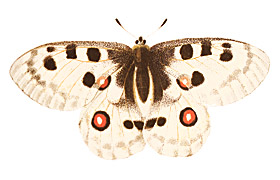Vi brukar varje år ha makaonfjärilar och jag har tittat i omgivningarna efter värdväxter, eftersom jag tycker att larven är så vacker, därför blev jag mycket förvånad när jag hittade nio larver av olika storlek på mina Moses brinnande buske (vacker giftig trädgårdsväxt som avger eteriska oljor, varma stilla kvällar lär det gå tända på den, finns omnämnd i Bibeln därav namnet).
Någon annan som sett samma sak?
Hur kan larven klara av att äta denna växt som anses så giftig?
Elsa Z Kniva Falun











Hej,
Det finns andra arter i makaonsläktet Papilio som kan använda Moses brinnande buske (Dictamnus albus L.) som värdväxt, till exempel Giant Swallowtail, Papilio cresphontes, som det står om här http://entnemdept.ufl.edu/creatures/citrus/giantswallowtail.htm Det finns faktiskt även enstaka observationer av makaonfjärilslarver som lever på Moses brinnande buske (se nedan). Med andra ord verkar släktet Papilio potentiellt kunna leva på arten men det sker mest i undantagsfall. Intressant observation!
Bästa hälsn Lars
Utdrag ut medlemsblad (http://www.bc-eig.org.uk/downloads/EIGfour.pdf) för European Interests Group (http://www.bc-eig.org.uk) i Butterfly Conservation:
Jozef Sulyok, botanist of the Bukk National Park, took us to a relic of the steppe comprising Loess (wind blown sand) a relict similar to the Ukraine.. Jozef started to survey this unique area of transitional forest/steppe last year recording a dynamic, mosaic distribution of plants. Over 50 special plants were identified and these included the endemic Hungarian rose, Rosa hungariana, with leaves that smelt of cinnamon, and Fraxinella, (Dictamnus albus), whose stems exude an inflammable oil - the Burning Bush . A Swallowtail larva (P.machaon) was feeding on this bush which was an interesting observation. Three milk vetches were identified, (Astragulus glycophyllus, A.austriacus, A.dasyanthus), A.dasyanthus is of particular interest as it is the foodplant for the Zephyr Blue. Inula hirta was pointed out as being a typical plant of the forest/steppe. The Toothed Orchid (Orchis tridentate) and Lady Orchid (O. purpurea) were two orchids also seen. The area is grazed with Hungarian grey cattle. It was good to hear that this site is protected as a Site of Special Interest 2000. The day was rounded off by supper at Farm Lator which was delicious as well as providing an insight into accommodation fitting well with eco tourism where you will all be welcome.